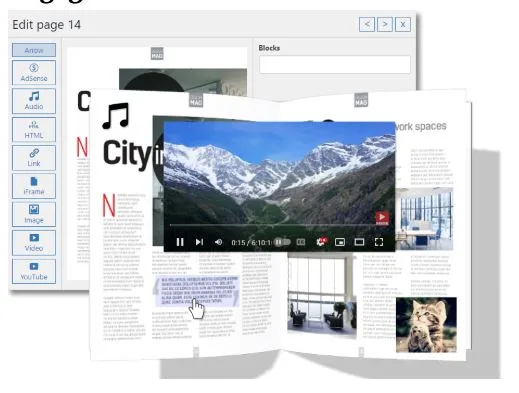From Static to Stunning: How 3D Flipbooks Supercharge Website Engagement
Digital audiences today expect more than flat, static documents. They want interaction, movement, and experiences that feel intuitive and enjoyable. This shift in expectations has pushed brands, creators, and publishers to rethink how they present content online. One of the most effective solutions that has emerged in recent years is the use of 3D flipbooks. By transforming traditional PDFs into immersive, page-turning experiences, businesses can unlock better engagement, longer sessions, and a more memorable user journey.
As an SEO expert who studies how content formats influence user behavior, I have seen a clear trend. Websites that replace old PDF downloads with interactive 3D formats consistently earn higher dwell time and stronger user engagement. They also benefit from improved content visibility since search engines reward pages that keep visitors active and satisfied. This article explores why this transformation matters and how 3D flipbooks have become one of the most powerful interactive content ideas for the modern web.
The Problem With Traditional PDFs in a Web Environment
PDFs have long been the default format for brochures, catalogs, guides, and reports. While they are convenient offline, they create friction online. Visitors often need to wait for a file to download, switch to a new browser tab, or scroll through long static pages that feel disconnected from the main website. Every extra step increases the chance of losing a visitor.
Static documents also break the flow of engagement. A visitor reading a PDF is no longer interacting with the website itself, so they are more likely to close the tab. The experience feels isolated rather than integrated.
A common debate in digital content management is the difference between a static PDF vs. interactive flipbook. PDFs are passive. They leave no room for movement, animation, or interactivity. Flipbooks, on the other hand, bring content to life with a real sense of depth and motion. They recreate the familiar act of turning a page while adding features that encourage exploration.
The Rise of 3D Flipbooks as a Modern Engagement Tool
3D flipbooks solve the limitations of static documents by transforming them into dynamic viewing experiences. Pages can turn with realistic movement, images can enlarge when clicked, videos can play inside the document, and links stay active. Everything feels smooth and unified with the rest of the website.
This interactive layer is not only visually appealing but strategically powerful. It gives visitors a reason to stay longer. When users feel compelled to click, flip, zoom, or search inside a document, they become more invested. This deeper involvement naturally leads to improving dwell time with interactive documents, which is a major advantage for SEO.
Modern flipbook tools are also optimized for mobile devices. Instead of pinching and zooming on a rigid PDF, users can swipe through pages, tap elements, and enjoy a touch-friendly interface that feels natural.
How 3D Flipbooks Improve the User Experience
User experience is one of the strongest factors influencing engagement and conversion. The shift from static PDFs to 3D flipbooks enhances UX in several ways.
1. Faster and smoother content delivery
Flipbooks load directly on the webpage without forcing users to download anything. This reduces friction and keeps visitors engaged from the moment they arrive.
2. Realistic page-turning motion
Visual motion attracts the human eye. The subtle animation of turning pages keeps users interested and encourages them to continue reading.
3. Interactive media options
Flipbooks can include:
- Videos and GIFs
- Hyperlinks
- Image popups
- Searchable text
- Embedded forms
- Audio clips
These elements turn passive reading into a hands-on experience.
4. Better mobile readability
Unlike static PDFs, which often appear tiny on mobile screens, flipbooks adapt to the device. Navigation remains easy, and content feels intentionally designed for small screens.
5. Increased content retention
When users actively interact with content, they remember it better. This is valuable for educational materials, product presentations, catalogs, and promotional content.
Why Flipbooks Keep Visitors on Your Website Longer
Search engines closely monitor how long visitors stay on a page. Longer sessions typically indicate that content is meaningful and helpful. When you boost website engagement with flipbooks, you offer something visually captivating and enjoyable, which naturally extends the time visitors spend exploring.
Several factors contribute to this extended engagement:
Multiple touchpoints within a single experience
A flipbook can hold hundreds of pages, interactive elements, visuals, and links, all accessible without leaving the website. Users feel more in control and curious.
Reduced bounce rates
Visitors who click into a flipbook are less likely to leave immediately. The interactive nature of the document encourages them to browse deeper.
A sense of novelty
The 3D effect creates a moment of surprise and delight. People enjoy experiences that feel unique and return to websites that offer fresh ways to consume information.
Enhanced storytelling
Whether it is a magazine, product showcase, or guide, a flipbook frames content in a narrative style. This keeps readers turning pages and reduces the risk of early exit.
Practical Ways Businesses Are Using 3D Flipbooks
The versatility of 3D flipbooks makes them useful for almost any business or content type. Brands worldwide are adopting them for a wide range of applications. Some of the most common uses include:
- Product catalogs for ecommerce
- Digital magazines and newsletters
- Interactive brochures
- Annual reports and business presentations
- Course materials and online learning resources
- Portfolios for photographers or designers
- Real estate listings and property guides
- Restaurant menus and event programs
These examples work well because they rely on visuals, detailed information, and structured page layouts that benefit from interactive navigation.
If your website runs on a popular CMS, integrating this format is easier than ever. Using tools like a WordPress Flipbook plugin allows creators to upload PDFs and automatically convert them into 3D interactive content that fits seamlessly into any page.
Flipbooks as a Strategic SEO Advantage
From an SEO perspective, 3D flipbooks contribute to better performance in several ways. A key factor is the behavior of users. Search engines reward websites that keep people engaged, and flipbooks excel in this area.
How flipbooks indirectly support SEO
- They reduce bounce rates by encouraging interaction.
- They create more internal link opportunities within the flipbook.
- They increase dwell time, which signals positive user engagement.
- They make content more shareable across social platforms.
- They improve the perceived quality of the website, which builds trust.
Flipbooks also help repurpose existing content. Instead of rewriting brochures or guides, businesses can simply convert their PDFs into an interactive format. This preserves the value of the original content while giving it new life.
Tips for Creating High Performing 3D Flipbooks
Not all flipbooks perform equally well. To maximize engagement, a few strategic guidelines can help.
- Use high quality images to maintain visual clarity.
- Keep page layouts clean and easy to navigate.
- Add hyperlinks to important sections or related pages.
- Include a clickable table of contents to guide readers.
- Embed videos where appropriate to enhance storytelling.
- Ensure mobile responsiveness is prioritized.
- Test loading speed before publishing.
- Use clear, readable fonts that work across screens.
These small details can make a flipbook feel more polished and professional, improving both user satisfaction and engagement metrics.
The Impact of Interactive Content on Modern Websites
The shift toward interactive content ideas reflects how digital audiences prefer to engage today. People expect experiences that feel responsive, visually appealing, and immersive. 3D flipbooks meet these expectations while offering measurable improvements in user behavior.
Businesses that adopt flipbooks often report:
- Significant increases in page views
- Longer average session durations
- Higher engagement with product content
- Improved conversion rates for catalogs and brochures
- Better user satisfaction overall
The transformation from static to dynamic content represents a major opportunity. Websites that embrace interactive formats position themselves as modern, innovative, and user focused. This not only boosts engagement but also strengthens brand perception.
Why Now Is the Best Time to Upgrade Your Content
Digital competition continues to grow. Users have endless options and will quickly leave websites that feel outdated or unengaging. Introducing 3D flipbooks is a simple yet powerful way to stand out. It offers an immediate upgrade to how content is presented and consumed.
For businesses that rely heavily on brochures, reports, catalogs, or downloadable material, this shift can make a meaningful difference. It bridges the gap between print style design and digital interactivity. It also ensures your most valuable content works harder for you by keeping visitors engaged.
Adopting 3D flipbooks is not just about aesthetics. It is about delivering a better experience, increasing user satisfaction, and aligning your website with modern expectations. If your goal is to hold attention, encourage exploration, and create memorable interactions, flipbooks offer one of the most effective solutions available today.





